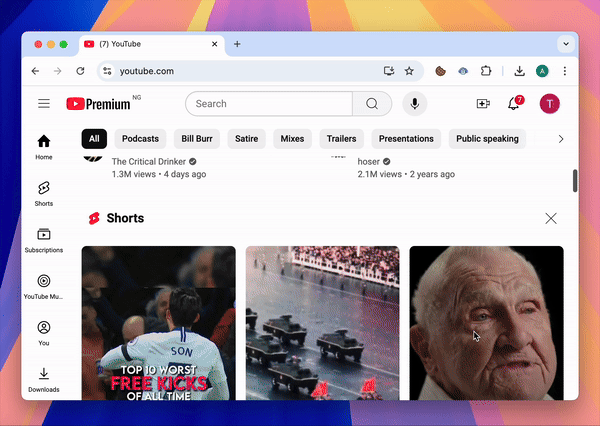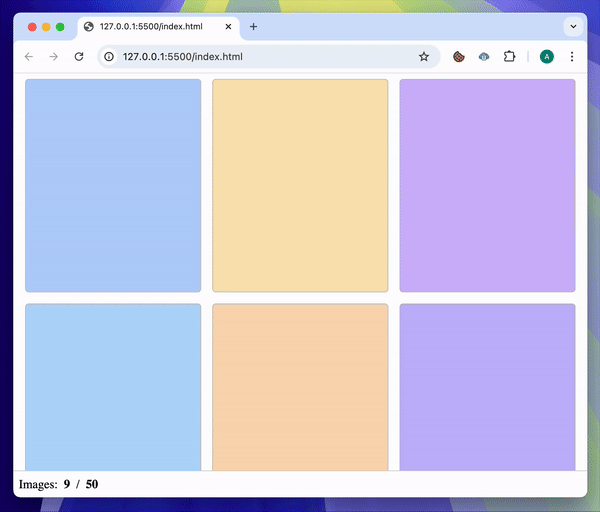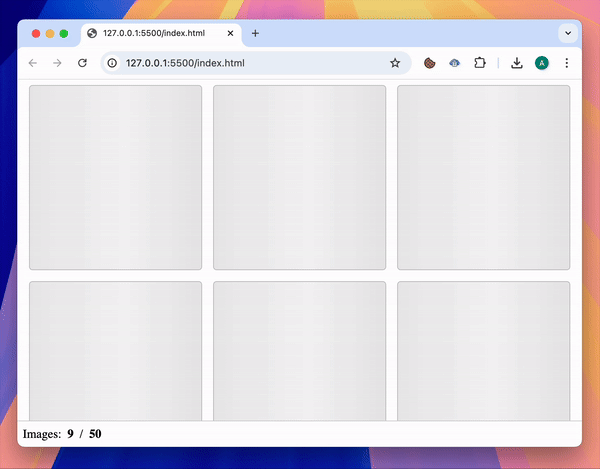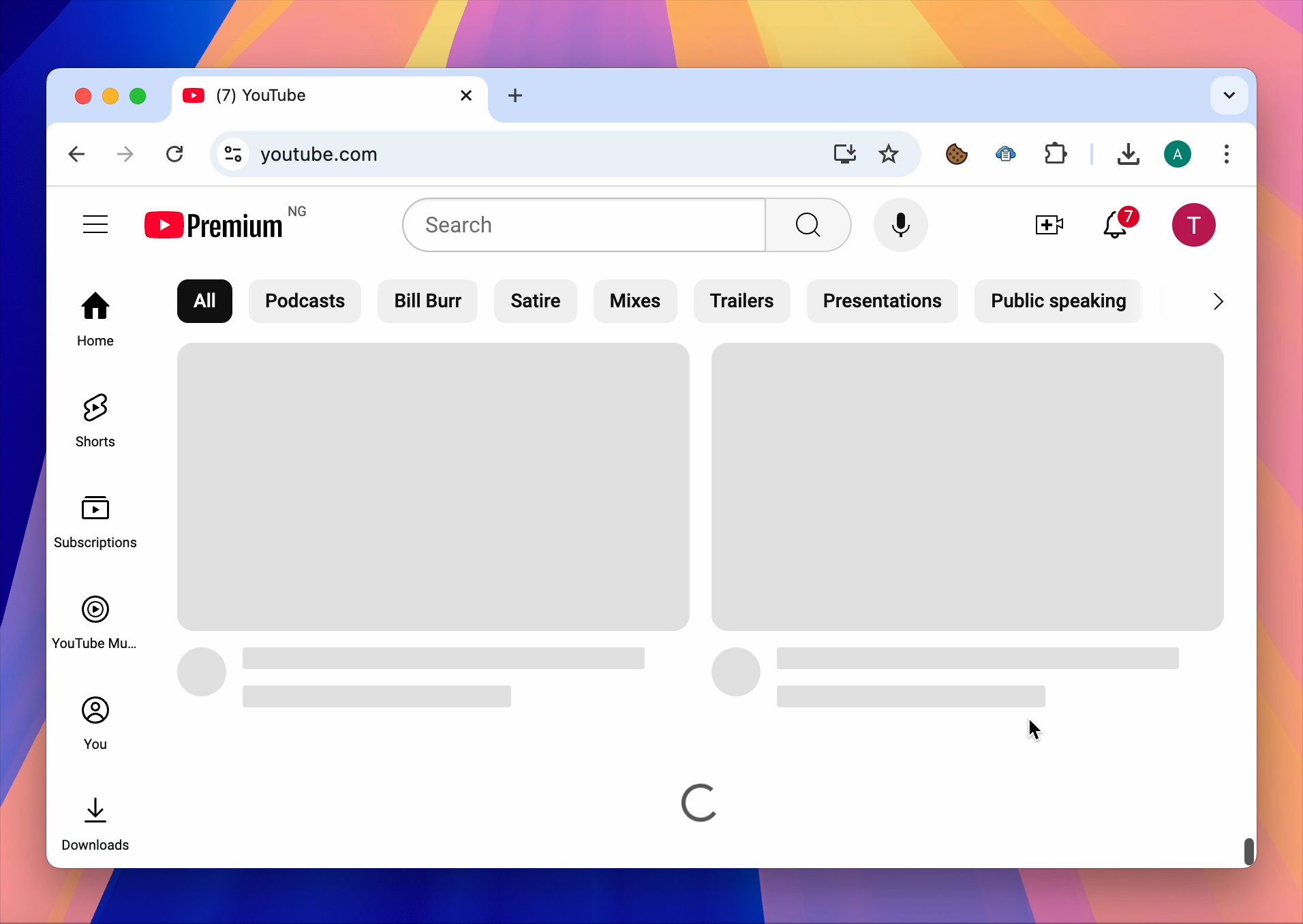Infinite scroll: Loading more and more content as the user scrolls down to the end.

No need for pagination + increases time spent on the site
With simple JavaScript we can recreate this easily:

We start with the basic HTML:
<div id="load-trigger-wrapper">
<!-- Grid of images>
<div id="image-container"></div>
<!-- Intersection Observer observes this -->
<
<div id="load-trigger"></div>
</div>
<!-- Number of loading images -->
<div id="bottom-panel">
Images:
<b><span id="image-count"></span>
</b>/
<b><span id="image-total"></span></b>
</div>Now it’s time to detect scrolling to the end with the Intersection Observer API:
const loadTrigger = document.getElementById('load-trigger');
// ...
const observer = detectScroll();
// ...
// Detect when
function detectScroll() {
const observer = new IntersectionObserver(
// Callback also runs after observe()
(entries) => {
for (const entry of entries) {
// ...
loadMoreImages();
// ...
}
},
// Set "rootMargin" because of #bottom-panel height
// 30px upwards from the bottom
{ rootMargin: '-30px' }
);
// Start watching #load-trigger div
observer.observe(loadTrigger);
return observer;
}
Now let’s show the initial skeleton images:
const imageClass = 'image';
const skeletonImageClass = 'skeleton-image';
// ...
// This function would make requests to an image server
function loadMoreImages() {
const newImageElements = [];
// ...
for (let i = 0; i < amountToLoad; i++) {
const image = document.createElement('div');
// 👇 Display each image with skeleton-image class
image.classList.add(imageClass, skeletonImageClass);
// Include image in container
imageContainer.appendChild(image);
// Store in temp array to update with actual image when loaded
newImageElements.push(image);
}
// ...
}.image,
.skeleton-image {
height: 50vh;
border-radius: 5px;
border: 1px solid #c0c0c0;
/* Three per row, with space for margin */
width: calc((100% / 3) - 24px);
/* Initial color before loading animation */
background-color: #eaeaea;
/* Grid spacing */
margin: 8px;
/* Fit into grid */
display: inline-block;
}
.skeleton-image {
transition: all 200ms ease-in;
/* Contain ::after element with absolute positioning */
position: relative;
/* Prevent overflow from ::after element */
overflow: hidden;
}
.skeleton-image::after {
content: "";
/* Cover .skeleton-image div*/
position: absolute;
top: 0;
right: 0;
bottom: 0;
left: 0;
/* Setup for slide-in animation */
transform: translateX(-100%);
/* Loader image */
background-image: linear-gradient(90deg, rgba(255, 255, 255, 0) 0, rgba(255, 255, 255, 0.2) 20%, rgba(255, 255, 255, 0.5) 60%, rgba(255, 255, 255, 0));
/* Continue animation until image load*/
animation: load 1s infinite;
}
@keyframes load {
/* Slide-in animation */
100% {
transform: translateX(100%)
}
}
Update skeleton images
We get colors instead of images.
function loadMoreImages() {
// ...
// Create skeleton images and stored them in "newImageElements" variable
// Simulate delay from network request
setTimeout(() => {
// Colors instead of images
const colors = getColors(amountToLoad);
for (let i = 0; i < colors.length; i++) {
const color = colors[i];
// 👇 Remove skeleton loading indicator and show color
newImageElements[i].classList.remove(skeletonImageClass);
newImageElements[i].style.backgroundColor = color;
}
}, 2000);
// ...
}
function getColors(count) {
const result = [];
let randUrl = undefined;
while (result.length < count) {
// Prevent duplicate images
while (!randUrl || result.includes(randUrl)) {
randUrl = getRandomColor();
}
result.push(randUrl);
}
return result;
}
function getRandomColor() {
const h = Math.floor(Math.random() * 360);
return `hsl(${h}deg, 90%, 85%)`;
}Stop infinite scroll
This is a demo so we’ll have a artificial number of images like 50.
const imageCountText = document.getElementById('image-count');
// ...
let imagesShown = 0;
// ...
function loadMoreImages() {
// ...
const amountToLoad = Math.min(loadLimit, imageLimit - imagesShown);
// Load skeleton images...
// Update skeleton images...
// Update image count
imagesShown += amountToLoad;
imageCountText.innerText = imagesShown;
if (imagesShown === imageLimit) {
observer.unobserve(loadTrigger);
}
}Optimize performance with throttling
By using a throttle function to only allow new loadings within a certain time.
let throttleTimer;
// Only one image batch can be loaded within a second
const throttleTime = 1000;
// ...
function throttle(callback, time) {
// Prevent additional calls until timeout elapses
if (throttleTimer) {
console.log('throttling');
return;
}
throttleTimer = true;
setTimeout(() => {
callback();
// Allow additional calls after timeout elapses
throttleTimer = false;
}, time);
}By calling throttle() in the Intersection Observer’s callback with a time of 1000, we ensure that loadMoreImages() is never called multiple times within a second.
function detectScroll() {
const observer = new IntersectionObserver(
(entries) => {
// ...
throttle(() => {
loadMoreImages();
}, throttleTime);
}
}
},
// ...
);
// ...
}11 Amazing New JavaScript Features in ES13
This guide will bring you up to speed with all the latest features added in ECMAScript 13. These powerful new features will modernize your JavaScript with shorter and more expressive code.


Nice work.